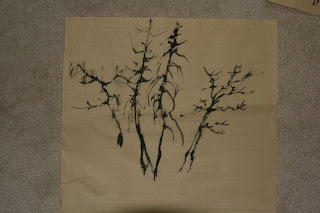I don't know why but I've always liked the pose of a ballerina on toes. Perhaps that stance forces the dancer to assume a good posture, tensing the right muscles to place the center of gravity within the confines of the mere square inches of footprint. Toeprint in this case. The pose inexplicably projects energy, or Chi, as I call it.
Chi is something a Chinese brush artist relishes and reveres. Our brushstrokes must exemplify Chi. One can tell if a snake or a worm is dead or alive without them moving. Perhaps dead things look desiccated and deflated, that's how we know. Bad brushstrokes lack Chi, they look withered.
Perhaps I had one too many music box with a twirling ballerina to play with as a kid, that image is seared in my mind. I would often doodle a ballet dancer. As I come to find out, there's a fancy term for it. They call it gesture drawing.
I suppose my Whiter Shade of Pale painting of 16 Vestals is a culmination of different gestures, albeit not of ballerinas. Even before that painting I've done studies of dance movements and martial arts movements.
The last two examples are from me playing with silhouettes as in void spaces. In traditional Chinese brush techniques I was taught that ink has 6 colors (some schools would say 5) and we should strive to achieve them. We consider Chinese ink as a color, and the 6 colors of ink ( perhaps more appropriately the 6 variations ) is dry, moist, saturated, light, burnt and strangely. white (actually means absence of ink; a void space in the western vernacular ). Thus a brushstroke with saturated ink may look dry, or moist, or burnt; depending on the manipulation by the artist, and more than one attribute could exist at the same time. A brushstroke with light ink is therefore not necessarily dry in appearance. When we speak of the "white" color in ink, we are referring to how the "white" defines or complements the black. Sort of like the theory about employing "voids" in the western discipline. Generally speaking, there are often more "whites" or blanks in a Chinese painting. Bodies of water, waterfalls and the sky are usually left blank. "Whites" are often preferred even with a "saturated" black brushstroke. White streaks left in a bamboo stem brushstroke help to define texture and adds character. My teachers often barked at me, " Liu Bai, Liu Bai !" ( Liu means "to save" and Bai means "white", so the phrase means leave room for voids.) For that reason we don't usually use a white pigment to paint "white" but opt to leave the space blank instead. Some schools will go as far to say that only a Chinese could understand these concepts. Thus my void silhouettes are actually using dark ink to define an empty space and allow our mind to see what it wants to see. My "saturated" ink was an example of it looking "moist" in that last silhouette by the way, and the "white" was used to complement the "black".
As I was playing with and shuffling these studies, somehow my silhouette paintings were superimposed on the other line drawings. One of my silhouette painting was done on a piece of very translucent cicada skin Xuan, and allowed the bottom painting of martial artists to come through.
That gave me an idea of mounting the two paintings together, superimposed. This is like working with layers in Photoshop. How exciting! I only wished I could control the degree of transparency from each layer.
My silhouette painting would be the top layer, so it goes face down first. Since the paper is so thin and delicate, wetting it and flattening out the wrinkles was not an exercise for the faint of heart. I learned throughout the years that I needed to treat it like attaching window tinting. I had to use copious amount of water to float the paper, so that it could be shifted slightly or flattened. It was counterintuitive but it worked.
I used a soft brush to apply starch and squeeze out the wrinkles.


























